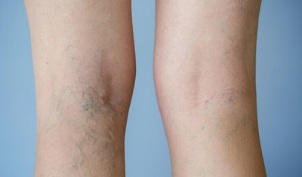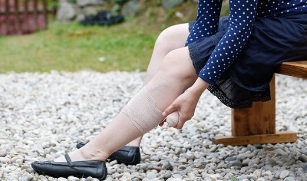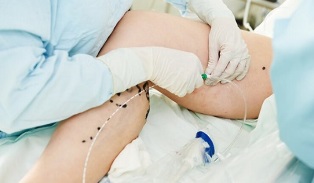
Signs of varicose veins of the legs in women are often found - this pathology is detected in almost one in three women. This disease, accompanied by an expansion of the lumen and thinning of the walls of the venous vessels, not only leads to the appearance of cosmetic defects, but is also accompanied by pain and malnutrition of the tissues of the lower extremities. As a result, if left untreated, a woman can develop trophic ulcers on her legs, leading to even more serious complications. That is why the start of treatment for varicose veins should always be opportune.
Signs of varicose veins of the legs in women are not always noticeable in the early stages - sometimes the disease lasts for a long time.
Causes and early signs
The veins of the legs are affected by varicose veins under the influence of the following factors:
- overweight; heredity
- ;
- sedentary lifestyle;
- long stay in static position;
- pregnancy;
- childbirth;
- taking high-dose contraceptives;
- increased abdominal pressure with frequent or prolonged coughing, sneezing or constipation; overload
- during physical training or exertion;
- leg injuries;
- pelvic pathology;
- overuse of tanning or thermal treatments;
- wear uncomfortable shoes;
- the habit of sitting cross-legged;
- alcohol abuse;
- old age.
Due to the increased pressure in the venous vessels and the stagnation of the blood, the vessels stretch out, the blood flowing through them changes direction and flow, as the walls of the vessels change toneand the valves stop working normally. As a result, changes in the veins lead to the development of a vicious circle in hemodynamics and other functions of the venous vessels.
At the initial stage of varicose veins, the blood flow can still be compensated by conservative means - wearing compression underwear, gymnastics and the use of venotonic drugs. However, as the disease progresses, changes in the structure of the veins become irreversible and can only be removed surgically.
Symptoms of varicose veins can drastically interfere with your usual pace of life.
The following manifestations can become the first signs of varicose veins in the legs:

- heaviness in the legs;
- the appearance of telangiectasias - spider veins and meshes of different colors (bluish, red, black);
- feeling of fullness during a long stay in a still position (sitting, standing);
- convulsions at night;
- relief of symptoms after walking or resting in a horizontal position.
Often the first manifestations of this common illness are attributed to fatigue and a visit to the doctor may be postponed until the serious consequences of the illness appear. As the expansion of the venous walls progresses, the symptoms become more pronounced, and then new ones are added to the above manifestations.
Symptoms
Varicose enlargement in later stages is manifested by the following symptoms:
- rapid fatigue in the legs;
- pain;
- feeling full of liquid;
- swelling of soft tissues after exercise;
- translucency and protrusion of large veins above the skin;
- itchy skin;
- bruising due to rupture of large vessels;
- peeling of the skin;
- hair loss;
- trophic ulcers.
Against the background of varicose veins in women, blood clots - thrombi - can form in the lumen of the veins. When they migrate into the bloodstream, consequences of various severity develop: thrombosis, flembothrombosis, development of cardiovascular diseases, opening and suppuration of ulcers, penetration of blood clots into the vessels of the heart or lungs.
Diagnosis and treatment
To confirm the diagnosis, a woman should contact a vascular surgeon and have an examination. The diagnostic plan includes an examination with instrumental studies:
- Doppler ultrasound of the vessels of the leg;
- duplex angioscanning;
- rheovasography;
- X-ray and radionuclide methods.
The tactics of treating varicose veins in the legs is determined by the stage of the disease. Conservative means can be used from the start:
- wearing compression stockings or bandaged with elastic bandages;
- sufficient physical activity;
- wear comfortable shoes;
- physiotherapy exercises;
- elimination of static load on the legs;
- application of venotonics.
The duration of conservative treatment is individual and depends on the rate of progression of the disease and compliance with the recommendations of the doctor. It can be supplemented with a special diet, involving the introduction of foods into the diet that help strengthen the walls of blood vessels.
The likelihood of varicose veins receding under the onslaught of conservative treatments is determined by each clinical case. In many ways, the success of therapy depends on the speed of a visit to a doctor.
In addition, these methods of treatment are recommended at the stage of preparation for surgical treatment or for patients who are contraindicated for invasive intervention.
Sometimes, preventing the progression of varicose veins may include minimally invasive procedures. They are applicable only for strict indications, which are determined during the examination of the patient.
Treatment of advanced varicose veins usually involves surgery - minimally invasive or conventional.

If possible, radical treatment of varicose veins of the legs is recommended for a woman:
- compression sclerotherapy
- ; Laser coagulation
- ; photocoagulation
- ; Radiofrequency coagulation
- .
If the impact of these minimally invasive techniques is not sufficient, then for a more radical surgical treatment, classic operations are performed:
- miniflebectomy; phlebectomy
- ;
- Trendelenburg method (with complications from thrombosis and infection).
Sometimes classical surgical techniques are supplemented by the use of minimally invasive techniques. Such a combination makes it possible to reduce the trauma of operations and shortens the period of postoperative rehabilitation.
Varicose veins of the lower extremities can be treated successfully, especially in the early stages. That is why the first signs of this disease should always become a reason to consult a vascular surgeon. Varicose veins can occur at different ages and observations show that women are more likely to suffer from this condition. The signs of varicose veins in the legs in women are the same as in men.




































